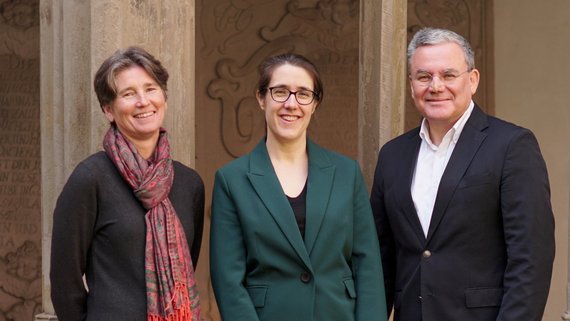On 1 July, the German Biobank Network (GBN) will be integrated into the Network of University Medicine (NUM) - an important step for the national biobank infrastructure. In future, the activities of the German Biobank Node and the German Biobank Alliance will be bundled under the established name GBN. GBN board members Dr Gabriele Anton, PD Dr Dr Michael Kiehntopf and PD Dr Sara Y. Nußbeck talk about what integration into the NUM means and what opportunities it offers in an interview.
The GBN coordinates the collaboration of human biobanks at academic medical centres and research institutions throughout Germany. At an international level, the GBN acts as the German representative in the European biobank network BBMRI-ERIC (Biobanking and BioMolecular resources Research Infrastructure - European Research Infrastructure Consortium). BBMRI-ERIC connects biobanks in over 20 countries and promotes networking, standardisation and quality in biobanking in Europe.
What does the integration of the GBN into the NUM mean and how did it come about?
Sara Y. Nußbeck: The merger with the NUM is a great success: it brings biobanks and researchers closer together and at the same time creates a long-term perspective for the GBN. The long-term stabilisation of the NUM as stipulated in the coalition agreement is also a huge opportunity for us.
Michael Kiehntopf: The close connection to the NUM is an important strategic step. It will enable us to anchor biobanking even more firmly as a cross-cutting topic in medical research - from clinical studies to data-driven research.
What advantages does it bring to the NUM?
Nußbeck: We have a well-established infrastructure, both nationally and at European level thanks to our connection to BBMRI-ERIC. Especially at EU level, it is becoming increasingly important to link biosamples and data more closely. This is already working well in the Scandinavian countries and we would like to build on this here in Germany. The NUM can benefit from our European experience.
Gabriele Anton: The local biobanks are already active in many NUM studies. Now the GBN Coordination Office is being added, which will strengthen the structure as a whole. We also contribute a lot in the area of training, for example through training courses and webinars.
Why is quality-assured biobanking so important for research?
Anton: Today, research takes place much more frequently across different sites. When biosamples from different clinics are brought together, it is crucial that they are collected and processed according to uniform standards. This is exactly what we ensure in the network.
Kiehntopf: This not only improves quality, but also the reproducibility of results. With the help of our audits and round robin tests, we can objectively check and continuously optimise processes. And we have done this over the years with measurable success.
Anton: Sample donors also benefit. They can be sure that their samples are handled responsibly and used as effectively as possible in research.
Where are the greatest synergies between GBN and NUM?
Nußbeck: Previously, some things ran in parallel that we can now bring together. Joint programmes can be established, particularly in the areas of training and audits. With our European perspective, we can also better harmonise national and international requirements.
Anton: The integration also brings many advantages in terms of IT systems and data platforms. In future, it will be easier to systematically merge clinical data and biosamples. We can also use tools such as the Sample Locator and the BBMRI-ERIC directory to increase the visibility of biosamples from Germany in Europe.
What are your hopes for the future under the NUM umbrella?
Nußbeck: Unlike in smaller countries, we have access to a large number of patients in Germany thanks to the large number of academic medical centres represented in the NUM. If we continue to develop this collaboration, we will strengthen our international competitiveness. COVID has shown: When everyone pulls together, many things happen faster. Now it's about implementing this sustainably.
How do you envisage the "National Biobank" envisaged in the coalition agreement?
Nußbeck: It fits in well with the idea of a nationally coordinated, decentralised biobank structure. The foundations are there: specialised local expertise and central coordination. What is needed is long-term funding, for example for flexibly deployable personnel. After all, biobanking depends on experience and qualifications.
Anton: Exactly, the structure is in place. Now it needs to be equipped so that it is ready for use at any time. Then we will also become even more attractive for industrial partners and be able to support research more quickly and effectively.
Kiehntopf: The quality assurance that has been established over the years is an important basis for transnational and reproducible research. A national biobank infrastructure must adopt and consistently maintain this quality standard.
Our interview partners:
Dr Gabriele Anton, GBN board member, biologist, head of the Ostwestfalen-Lippe Biobank at the Faculty of Medicine at Bielefeld University, co-coordinator of the "Biosample Hub" at NUM
PD Dr Dr Michael Kiehntopf, GBN board member, laboratory physician and biochemist, Head of the Integrated Biobank Jena (IBBJ) and the Institute for Clinical Chemistry and Laboratory Diagnostics at the University of Jena, Deputy Chairman of the Technology and Methods Platform for networked Medical Research e.V. (TMF e.V.)
PD Dr Sara Y. Nußbeck, GBN Board Spokesperson and National Node Director at BBMRI-ERIC, molecular biologist, Head of the Central Biobank at the Academic Medical Centre Göttingen (UMG)



